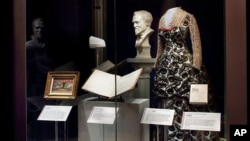A Smithsonian museum is launching a new initiative exploring the ways giving is woven into American life, whether it's a multimillion dollar school endowment, nights spent battling blazes by a volunteer firefighter or other contributions of time and money.
The National Museum of American History's announcement of a plan to collect, research and exhibit artifacts documenting the nation's legacy of philanthropy coincides with Giving Tuesday, a movement encouraging philanthropy in a season often associated with consumerism.
"Our goal is to help them understand what it means to be American, who we are as a people, and try to characterize what makes us distinctive," said Associate Director for Curatorial Affairs David Allison.
Allison said philanthropy is one element of that and the exploration seems a natural fit for an institution created by the philanthropy of James Smithson.
The British citizen left his estate to his nephew, but since the nephew died without an heir, the half million dollar estate went to the U.S. for the founding of "an establishment for the increase and diffusion of knowledge," according to the Smithsonian's website.
"The Smithsonian only exists because of philanthropy," Allison said, noting that Smithson's legacy of giving has been carried on by many others. "That's something that we as an institution should pay more attention to."
A grant from the Bill and Melinda Gates Foundation and a gift from David M. Rubenstein fund the Smithsonian's Philanthropy Initiative, with an annual symposium, display space and the endowment of a curatorial position, but neither wanted to disclose the amounts contributed.
The idea for the initiative grew out of the museum delving into the history of business in America for its recently opened innovation wing, Allison said.
"The role of philanthropy kept coming up," he said, but there wasn't space to include it then. "It made us think that we should do more on that topic."
Just as styles of giving have shifted from coins in a church collection plate to 10Ks and crowdfunding campaigns, so has the way museums engage their audiences, Allison said. This initiative embraces collaboration, putting out a call for artifacts of philanthropy, such as thermometers that organizations use to track progress toward a fundraising goal and inviting the public to share online their stories and photos about giving.
"The Smithsonian is really moving to a different relationship with its audience," he said. It's no longer a situation where the museum knows everything and tells you what you need to know, "those days are gone," he said. New ways of engaging the public, such as social media, create a larger conversation about the topic being explored.
The museum will open a long-term exhibition in late November 2016. In the meantime, "Giving in America" will give a preview of ways giving has shaped civic culture both in the Gilded Age and the present day. Artifacts gathered for the initiative include a nurse's cap from a Johns Hopkins University School of Nursing student circa 1945 and letters from signers of the Giving Pledge, a commitment by some of the world's richest people to dedicate a majority of their wealth to philanthropy.
Items being donated on Tuesday include a firefighter's boot used to collect money from motorists for the "Fill the Boot" campaign for muscular dystrophy and T-shirts, signs and a banner from the #BMoreGivesMore 2013 campaign in Baltimore.






